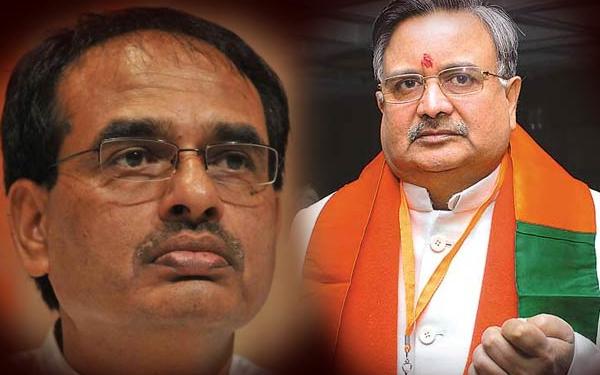Shivraj Singh Chouhan and Raman Singh, two great chief ministers who led their respective states from the status of underdeveloped states to the forefront of economic growth are now out of power. The two leaders held the fort for the saffron party along with Narendra Modi in Gujarat when it was reduced to a regional party. In the 2009 general election, BJP bagged only 18.8 percent of total votes and political pundits predicted that BJP will be wiped out from the political map of India very soon. But these three leaders kept the spirit of BJP alive and today, it is the largest political organization in the world.
Now as Shivraj Chouhan and Raman Singh are relieved of their responsibilities in their respective states, they might be considered by the BJP high command to fit in the central government, in the likelihood of the party coming back to power in 2019. The Modi cabinet will definitely be strengthened as they both have been very successful administrators. Both leaders have performed well on the administrative front as well as on the developmental front. The administrative expertise of both these leaders has been appreciated even by the opposition and left-liberal media establishment, which is generally critical of BJP governments.
A successful administrator is one who builds consensus. The leader having statesman’ calibre brings all stakeholders together on an issue irrespective of their alienations. Shivraj Singh Chouhan, three times CM of Madhya Pradesh is among such kind of political leaders in the country. When a particular section of society in MP started protesting over differences on Scheduled Caste and Scheduled Tribe (Prevention of Atrocities) Act, Chouhan government amended the law for instilling a sense of self-respect among upper castes and other backward classes (OBCs). The government also started a scheme named ‘Purohityam’ under which diploma course is being made available for the profession of the priesthood. People from all the sections of society including Scheduled Castes and Scheduled Tribes could enroll in diploma course and opt priesthood as a profession. These examples are enough to prove how he has been able to prevent backlash from the upper caste as well as bridge fault lines of the society.
MP was known as a region where dacoits, criminals had stronghold and lawlessness prevailed to a great extent. Since Chouhan assumed power, the state has been among the well-governed states of the country with law and order restored. The track record of Chouhan in last 13 years in the state makes him a very good candidate to lead the Home Ministry.
Shivraj Chouhan not just performed brilliantly on the administrative front but also performed exceptionally well on the developmental front. When BJP came to power in the state, MP’s share in the agricultural output of the country was 5 percent, it reached to 8 percent in 2014 and is expected to touch 10 percent by 2019. MP witnessed the highest agricultural growth in the country and Chouhan was praised by economists and policymakers across the globe for the agricultural performance of the state. Given the track record of Shivraj Singh Chouhan, he can also be assigned the Agriculture Ministry.
The state of Chhattisgarh was among the poorest regions of the country when it was separated from Madhya Pradesh in 2000. The fate of the state turned in next election when a ‘gentleman politician’, Dr. Raman Singh was chosen by the BJP for the post of CM in 2003. Despite being an upper caste Rajput, he governed a state with 32 percent tribals, 12 percent Scheduled Caste and 49 percent OBC population for 15 years. His caste constitutes less than 3 percent of the total population in the state. Also, the upper caste holds less than 10 percent of total vote share. The credit of elevating the politics in Chhattisgarh above the caste manipulations goes to Raman Singh.
On the administrative front, Raman Singh has been exceptional. He cooperated with the central government to take on the Maoist stronghold in the southern part of the state. He created Sadwa Judum, a state-sponsored independent organization which recruited tribal people to fight against fellow Maoist tribals. This shows the administrative genius of Raman Singh. There has hardly been any corruption charge on his government in the last one and a half decade. He played an instrumental role in solving the Naxalism problem in the state. In the words of former Prime Minister Manmohan Singh, Naxalism is, “The greatest internal security threat to our country” and Raman Singh could be the ideal candidate to solve this problem. Hence, Raman Singh can also be a good contender to head the Home Ministry.
The industrial growth of Chhattisgarh was one of the highest in the country under Raman Singh. Nagarnar Steel Plant was set up in Naxal-hit Bastar region. Nagarnar has become a world-class city with state of art infrastructure in his leadership. So, Raman Singh could be a good candidate for the Ministry of Commerce and Industry. He could give the much needed fillip to ‘Make in India’ in order to make the country the manufacturing hub to generate employment for millions of people.
Chhattisgarh and Madhya Pradesh are the best examples of how good leadership can transform the whole state and alleviate the living standards. Shivraj Chouhan and Raman Singh will be in the first line of the chief ministers of post-liberalized India who have successfully reaped the benefits of economic liberalization for the welfare of the people. They served the people of their state with utmost dignity, and now they may have some bigger roles to play.
































